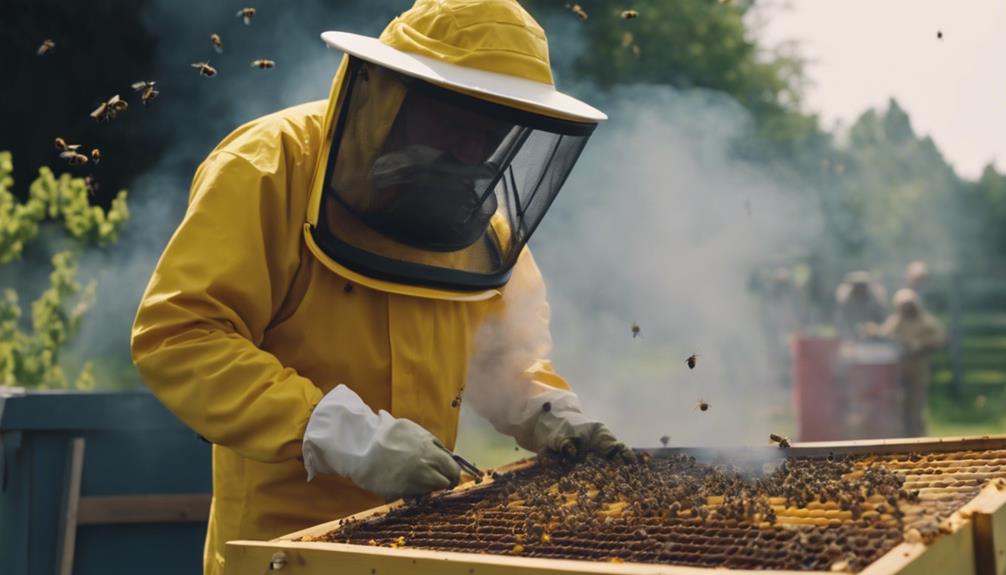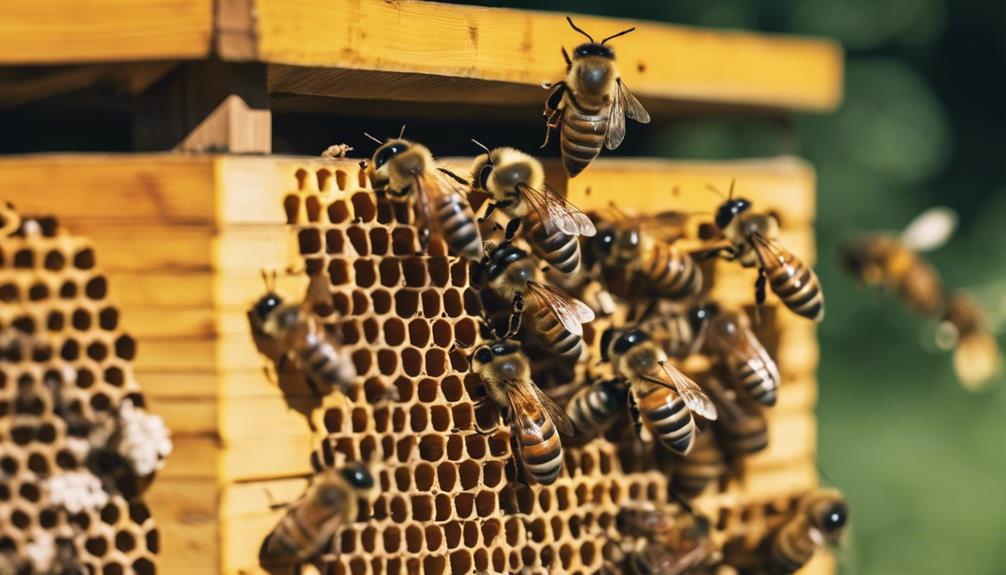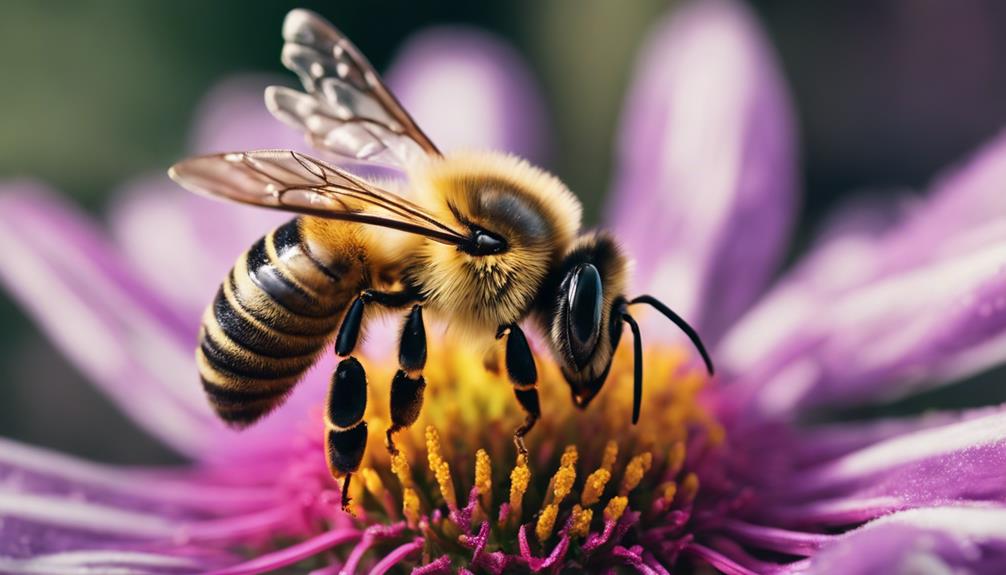When we handle bees, the bee smoker plays an essential role in keeping our little buzzers calm and collected. By cleverly using smoke, we create a serene space within the hive that helps the bees stay chill. Think of it like hitting the snooze button on their alarms, distracting them with a sudden craving for honey. Not only does the smoker make hive inspections easier, but it’s also a key tool for maintaining a harmonious relationship with our fuzzy friends. If you’re curious about the types of fuel or how beekeepers benefit from this nifty device, there’s a whole hive of information waiting for you.
Main Points
- Calms bees during hive inspections
- Masks bees’ alarm pheromones
- Enhances hive safety
- Facilitates efficient bee handling
- Creates a soothing environment
History of the Bee Smoker
The history of the bee smoker reveals its origins in the ancient practice of using smoke to calm bees for honey collection. Before the invention of the modern bee smoker, indigenous Native Americans ingeniously used smoke to anesthetize honeybees during hive inspections. This clever technique allowed them to gather honey without agitating the bees.
In 1873, Moses Quinby took this ancient practice to a new level by creating the first bee smoker. Quinby’s innovation transformed hive inspections and beekeeping practices. Later, Tracy F. Bingham further improved the bee smoker design in 1903 by patenting his modifications.
Remarkably, Moses Quinby decided against patenting his invention due to his Quaker beliefs, ensuring that this valuable tool remained accessible to all beekeepers.
How Smoke Calms Bees
After exploring the history of the bee smoker and its evolution, understanding how smoke calms bees is crucial for effective hive management and beekeeping practices. When we puff that gentle smoke into the hive, it’s like hitting the snooze button on a bee’s internal alarm clock.
The smoke masks the bees’ alarm pheromones, those chemical signals that scream, ‘Danger, danger!’ Instead of gearing up to defend the hive, the bees get distracted by a sudden craving for honey. It’s like offering a soothing cup of tea during a stressful moment.
Types of Bee Smoker Fuel
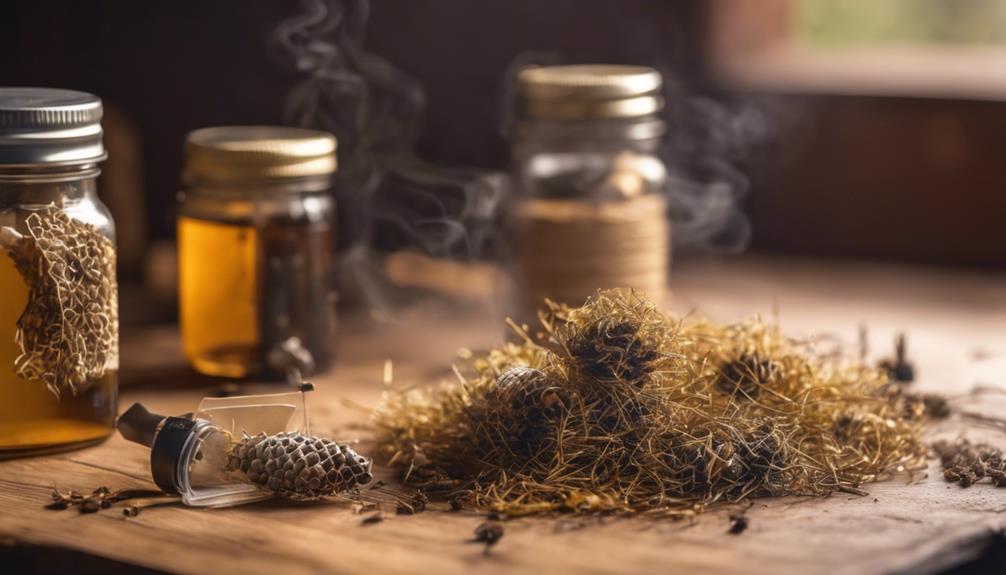
What materials can we use for fuel in bee smokers?
When it pertains to keeping our bees calm, choosing the right smoker fuel is vital. Some exceptional options include wood shavings, burlap, pine needles, wood pellets, twigs, or even cardboard. It’s important to avoid synthetic materials or bleached paper, as these can release harmful substances when burned.
Opt for fuel that burns slowly, ignites quickly, and produces smoke effectively to help calm the bees during hive inspections. Whether you gather materials from your surroundings or purchase them for convenience, having a good supply of smoker fuel on hand is essential for smooth beekeeping operations.
Let’s make sure our beekeeping practices are both effective and bee-friendly by selecting the right smoker fuel.
Benefits of Using a Bee Smoker
Using a bee smoker offers numerous advantages for beekeepers. It helps increase hive safety by keeping bees calm, making inspections less risky for us.
Additionally, the smoker facilitates the process by assisting in the handling of bees, allowing us to work more efficiently.
Increased Hive Safety
Bee smokers significantly boost hive safety by keeping bees calm during inspections through masking alarm pheromones. This vital tool plays a pivotal role in creating a peaceful environment for both beekeepers and bees.
When guard bees sense danger, they release alarm pheromones, signaling other bees to become defensive. However, the bee smoker’s smoke confuses these signals, calming the bees and preventing aggressive behavior. This guarantees that hive inspections can be carried out smoothly and safely, reducing the risk of stings and disturbances.
Calms Bees Effectively
To improve hive safety and promote a peaceful working environment, utilizing a bee smoker effectively calms bees by masking alarm pheromones. When we light the bee smoker and gently puff the smoke around the hive, it interrupts the bees’ communication and triggers them to focus on feeding rather than feeling defensive. This action creates a more relaxed atmosphere, making hive inspections smoother and safer for everyone involved.
Facilitates Hive Inspection
Facilitating hive inspections, the bee smoker plays an essential role in ensuring a safe and calm environment for both beekeepers and bees. The smoke helps beekeepers use this important tool effectively by calming the bees and reducing the risk of defensive behavior. Here’s how the bee smoker aids in hive inspections:
- Calms Bees: The smoke produced distracts the bees, encouraging them to focus on eating honey rather than feeling threatened.
- Reduces Defensive Behavior: By keeping the bees calm, the smoker minimizes the chances of aggressive responses during the inspection.
- Ensures Safety: Using a bee smoker is critical for maintaining a peaceful hive environment and safeguarding both the beekeeper and the bees during the inspection process.
Bee Smoker Design Features
When examining bee smoker design features, it’s vital to ponder the types of fuel utilized and the mechanism for regulating airflow. These aspects play a pivotal role in generating the appropriate amount of smoke to soothe bees during hive inspections.
Understanding how these design features collaborate can boost the effectiveness of beekeeping practices.
Fuel Types Used
Various fuels are used in bee smokers to produce smoke, including burlap, pine needles, wood pellets, twigs, or cardboard. It’s crucial to select materials that burn slowly, light quickly, and generate smoke effectively for your bee smoker. Here are some examples of suitable fuels for your bee smoker:
- Burlap: Burns slowly and produces a steady stream of smoke.
- Pine needles: Quick to light and gives off a pleasant, calming smoke.
- Twigs: Easily accessible and sustainable fuel option for beekeeping tasks.
Airflow Control Mechanism
The airflow control mechanism in bee smokers plays an essential role in regulating the amount of smoke released, allowing beekeepers to effectively manage hive inspections and bee behavior.
With the bellow attached to the smoker, we can control the smoke’s intensity and direction, ensuring the right amount enters the hive. This mechanism is like having a volume knob for the smoke, helping us create a calm environment for both the bees and the beekeeper during inspections.
Proper Bee Smoker Usage Techniques

Using a bee smoker correctly is essential for maintaining a calm hive environment during inspections. Here are some tips for proper bee smoker usage:
- Start the Fire Right: Begin by lighting the smoker with materials like cardboard or newspaper.
- Direct the Smoke Carefully: Use the hive tool to guide the cool smoke towards the hive entrance and top for effective calming.
- Moderation is Key: Avoid overwhelming the bees with excessive smoke; use additional puffs only if necessary during longer inspections.
Importance of Beekeeper Safety
Ensuring beekeeper safety is paramount in beekeeping practices.
In terms of hive inspections, utilizing a bee smoker is a game-changer. The bee smoker plays a vital role in creating a stress-free environment for both beekeepers and bees. By soothing the bees, it reduces the risk of stings and allows beekeepers to work in hives without interruptions or aggressive behavior from the bees.
This tool promotes smooth hive inspections, making the entire process safer and more efficient. Remember, a bee smoker isn’t just about managing the bees; it’s also about safeguarding the beekeeper.
Bee Smoker Maintenance Tips
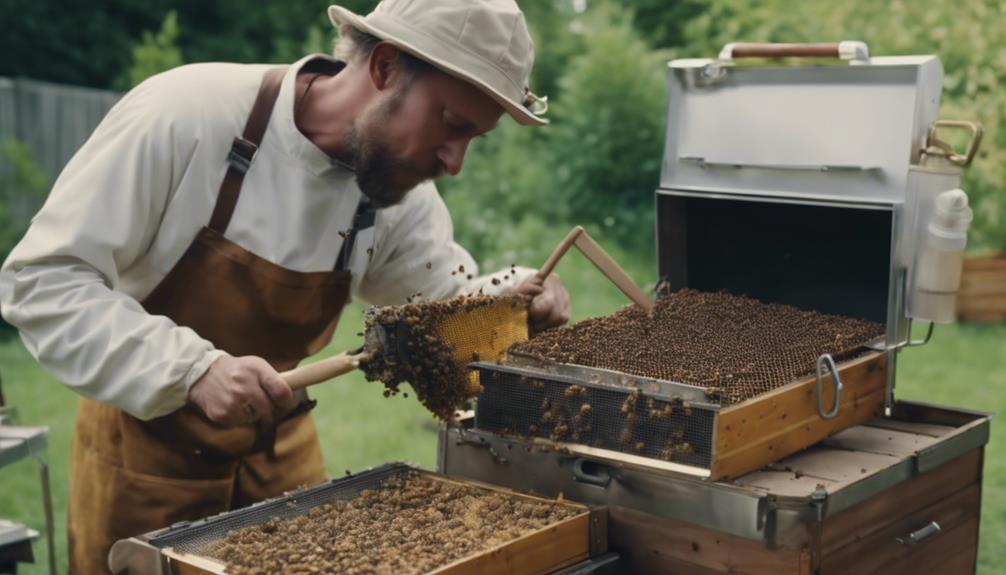
As beekeeper safety remains a top priority, maintaining the bee smoker through regular cleaning and inspection is crucial for peak performance.
In terms of bee smoker maintenance, there are a few key tips to keep in mind:
- Cleaning: Regularly cleanse the bee smoker to prevent debris buildup and guarantee it functions correctly.
- Fuel Replacement: Substitute the smoker’s fuel on a regular basis to sustain a consistent smoke output.
- Storage: Keep the bee smoker in a dry, well-ventilated area to prevent rust and deterioration.

Roger Thomas is a seasoned beekeeper and hive architect with a deep-seated passion for sustainable living. His fascination with bees has shaped his professional career, giving him practical and theoretical expertise in bee behavior, colony health, and optimal hive conditions. Roger’s technical skills shine in his bespoke hive creations that cater to the specific needs of diverse bee species, while his sustainable practices promote environmental balance and the wellbeing of the bee population.
As he continues his journey in beekeeping, Roger has become a dedicated advocate for responsible practices and an insightful educator in his field. His posts aim to inspire new beekeepers, underline the importance of sustainability, and showcase the remarkable contribution bees make to our ecosystem. Roger invites you to join him as he delves into the world of bees and the rewarding, honey-sweet art of beekeeping.
